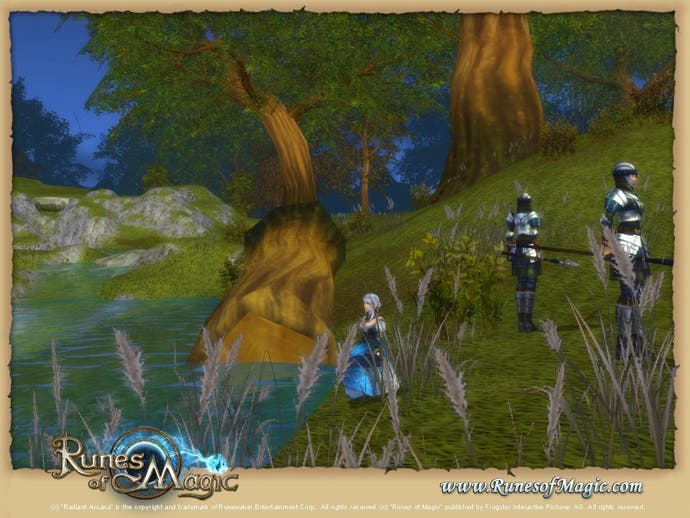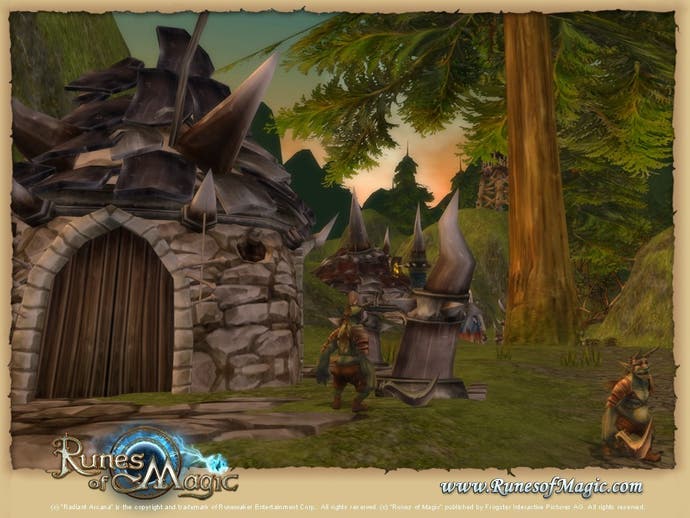Runes of Magic
Even better than the real thing?
There's no getting around the fact that the very name Runes of Magic sounds generic. And indeed, once you're past the character creation screen of this free-to-play MMORPG - where female avatars appear, primed to go into battle in metal panties and armoured stockings - the game itself doesn't refute this impression. However, games are generic, by and large, and to be considered thus isn't that much of a slur.
One ostensible slur that's been doing the rounds about Runes of Magic is that it's basically a World of Warcraft clone, but this misses the point. WOW was a success because of how well it built on MMO conventions, how it refined them. It's no surprise it's influential, but conversely it's got no great claim on gameworlds defined by cod-medievalism and pick-and-mix mythology (John Ronald Reuel plays a key role in such things), interfaces featuring text boxes, hotbars, mini-maps and health bars, and questing based on killing, collecting, delivering. Runes of Magic certainly features all these aspects. Indeed, it's so familiar that it's appreciably comfortable to pick up and play, if you've any experience with recent big MMORPGs. Okay, one in particular.
John and Tony Tang, the key players in Runewaker Entertainment Ltd, the Taiwanese company behind Runes of Magic and its Asian forebear Radiant Arcana, make no bones about being fans of Ultima Online, EverQuest and WOW. The look and feel of Runes of Magic are so closely comparable with Blizzard's game that Tauren somehow seem to have escaped Azeroth and made it to Runes of Magic's gameworld of Taborea. (I've yet to meet one, but I've met plenty of Kobolds, who, as in WOW, are rat-like and have a thing for candles.)

Thus far in closed beta, the only playable race is the humans, but the old fave elves are being readied for the launch early next year. And, thus far, there are only six fairly basic classes. However, one of the promising things about Runes of Magic is a pledge from Runewalker and Frogster (the German company handling the release of extensively reworked German and English versions of the game) is for new content - classes, races, quests and zones - every three or four months. This may sound like mere patching, but it's a substantial promise for a free-to-play game.
Free-to-play MMOs are nothing new, but Runes of Magic has the potential to really push the boundaries of this fast-growing sector. This is a game that's free to download and has no subscription, but in terms of grandeur, sophistication and depth, it migth almost be able to compete with the big boys. The starter area, where you begin grinding away on ambulatory mushrooms and wolves whose voices haven't broken yet, is nothing terribly special, but at level 10 you'll take your first jaunt to the city of Varanas, a vast, airy citadel of cathedral-like buildings looming over smaller timber-frame houses and shops that's like Stormwind's big brother.

Level 10 isn't just significant for the virtual tourism opportunities it opens up. It's when the game currently introduces what may be its trump card: dual classes. Your avatar will start as one of the six classes: warrior (weapon-specialist melee fighter); knight (tank and the only plate wearer); priest; mage; scout (the bow-user); and rogue. At level 10, however, you can choose a secondary class.
In principle, this sounds fantastic, a means of compensating for the game's lack of hybrid classes, and mixing things up Guild Wars-style. It has some problems as it currently stands, but is due to be completely reworked for the open beta in December.

